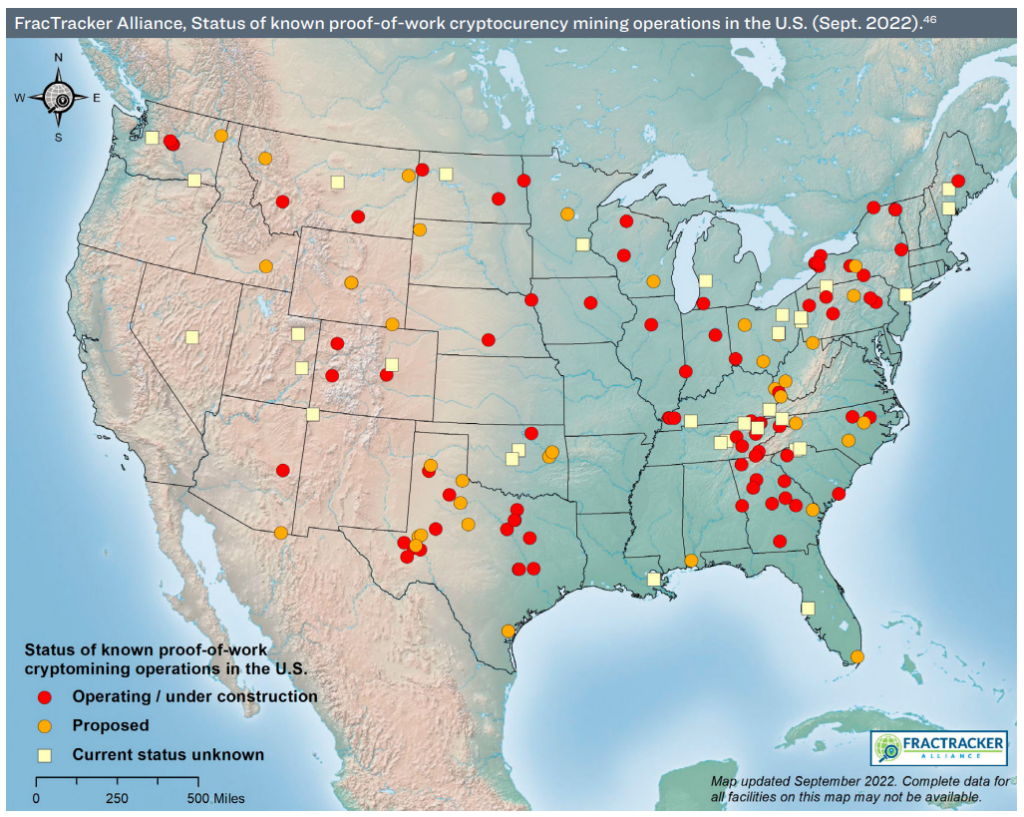- 1 Crypto miners’ acquisition of fossil fuel plants adds to rising carbon in the air.
- 2 Carbon emissions from crypto mining operations may vary from one location to another.
Proof-of-Work (PoW) cryptocurrencies have long been debated under the umbrella of energy consumption. Earthjustice, an environment-focused non-profit organization, explains in its report “THE ENERGY BOMB,” how these assets are worsening the climate crisis.
Coal Consumption is Still at Large Among Crypto Miners
The document highlights energy consumption by Bitcoin (BTC), the flagship cryptocurrency, boomed from a gigawatt (GW) a day in 2017 to 11 GW/day in 2022. The Office of Science and Technology Policy (OSTP), a department of the US government, estimates crypto mining takes up to 66 Billion kWh/year or up to 1.7 percent of total annual energy consumption in the country.
Primarily, China catered to global crypto mining operations until the government crackdown in 2021. Bitcoin mining, however, did not have much impact with much of computing transitioning to the US. Currently, the nation accounts for nearly 38 percent of global energy consumption by crypto mining operations.

Earthjustice, in their study, researched crypto mining facilities and located over 140 operations. It notes the usage of burning coal to generate electricity as one of the most destructive choices for the environment. Crypto miners’ acquisition of fossil fuel plants adds to rising carbon in the air.
The document reads, “We have identified several fossil fuel power plants where greenhouse gas (GHG) emissions and local pollution increased dramatically after those plants were acquired by cryptocurrency mining companies and began operating around-the-clock.”

The report adds that many companies also use electricity generated using oil and gas combustion. It may lead to the reopening of orphaned wells. Some miners capture methane from flaring to generate electricity. However, a California University professor describes it as a way to monetize flaring, not stop it.
Crypto Mining Accounted For Up To 76M Tonnes of GHG Emissions in The US
Moreover, Earthjustice believes the impact of crypto mining on climate and energy is substantial. Crypto miners do not readily disclose their energy consumption. The report says, “The most obvious way cryptocurrency mining increases global emissions is by driving huge increases in electricity demand.”
Electric Reliability Council of Texas (ERCOT), the state’s grid operator, estimates 33 GW of new cryptocurrency load to be interconnected by 2026. BTC mining operations in the US accounted for up to 76 Million tonnes of greenhouse emissions last year. As per the report, crypto mining “derails or reverse decarbonization in ways that go beyond simply adding electrical load.”
Cheap renewable energy prices in the US caused many coal plants to retire due to high cost and risk of operation. However, this made them attractive for crypto miners acting on short-term profit strategies. Low acquisition costs and operation-ready infrastructure make such facilities an economic opportunity for them.
Carbon emissions from crypto mining operations may vary from location to location. Marginal emissions, as Earthjustice puts it, emissions that are associated with incremental additions or reductions in demand lead to such variables. For example, a 300 MW data center in Texas may emit 1.6 Million tons of greenhouse gasses. Meanwhile, in North Dakota, the figure may convert to 2 Million.
Anurag is working as a fundamental writer for The Coin Republic since 2021. He likes to exercise his curious muscles and research deep into a topic. Though he covers various aspects of the crypto industry, he is quite passionate about the Web3, NFTs, Gaming, and Metaverse, and envisions them as the future of the (digital) economy. A reader & writer at heart, he calls himself an “average guitar player” and a fun footballer.


 Home
Home News
News






